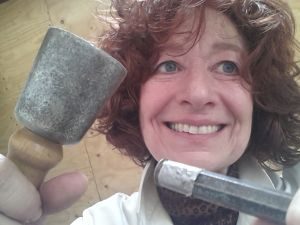 “Movement’ is a recurring theme in the work of Monique the sculptor and artist. Her small bronze sculptures “appear to dance away from their pedestal” wrote a visitor in the guestbook. The dynamic of the dancers and horses are an unending source of inspiration for Monique. She regularly attends dancing performances and has ridden horses for many years. In wood and stone she attempts to discover interesting patterns and contrasts between rough and smooth or round and straight shapes. She thinks a sculpture should automatically evoke viewing from all sides.
“Movement’ is a recurring theme in the work of Monique the sculptor and artist. Her small bronze sculptures “appear to dance away from their pedestal” wrote a visitor in the guestbook. The dynamic of the dancers and horses are an unending source of inspiration for Monique. She regularly attends dancing performances and has ridden horses for many years. In wood and stone she attempts to discover interesting patterns and contrasts between rough and smooth or round and straight shapes. She thinks a sculpture should automatically evoke viewing from all sides.
Birth of a passion
Twenty five years ago and by sheer luck, she was first acquainted with sculpture at the Gooise Academy of Visual Arts. She intended to enrol for drawing courses but all places had been taken. The tri-dimensionality of sculpture enthralled her at once: a passion was born. She followed the teaching of various professors to finally join the “Valkeveen Sculpture Group”, after which she acquired her own in-house workshop and became a member of the foundation “Art in Laren”. Many years of apprenticeship passed by before she wanted to discover the impact that her work could have on a larger public. It was in 2016 that she first opened her workshop to the public during a studio event in her native city of Laren (The Netherlands).
Focus on sculpture
This set a change in her life in motion. Many visited to her studio, when she would hear laudatory comments such as: “it all seems alive”, “superb collection, remarkable professionalism”, “everything moves and has soul of its own”, “what a dynamic in these sculptures”, “very professional, superb”, “beautiful drawings with dance expression”, ”superb vigorous work”. After a career in communications, Monique now focuses on sculpture and accepts only very selective commissions as a communication advisor and trainer. She lives alternately in the Netherlands and on the Spanish Costa Blanca where she has regular exhibitions .
Partial to wax and stone
Monique uses various materials but predominantly wax. This material demands swift handling or too quickly it turns soft and unuseable. During winter months in Spain she is able to work in wax until the weather turns too hot. Wax is suitable to capture an impression, an expressive fleeting moment that can thereafter be transposed into bronze, an expensive but invaluable material. Dancers and horses are Monique’s preferred subjects though she enjoys also working with human models.
Figurative as well as abstract
Whether in wax, clay or stucco, Monique creates figurative objects. In wood and stone her sculptures spontaneously become more abstract. The grains in the wood or the patterns of the stone (as French limestone, serpentine or marble) lead her to the final sculpture. This means slowly chiselling the material away, which after a long search reveals the ultimate shape. Spain is rich in beautiful marble, “rojo de Alicante” and “crema marfil” which Monique prefers. The quarries lie close to Alicante, which isn’t not far from her alternate Spanish home.
The capture of movement in drawings
Her initial interest in model drawing was to acquire a better knowledge of the human anatomy that she could then transfer into her sculptures. Monique has become fascinated by the contrast between swift drawing and working more slowly creating artisanal sculptures. She very quickly draws from models and moving dancers. She then “captures” the movement in rapid charcoal, pastel or ink sketches. Only short poses are possible of a live subject that might last one, two, five or ten minutes however dancers just keep moving. This is also an inspiration for her sculptures. A movement that has been imprinted in her mind is later transferred into a sculpture. Monique: ”I have so many sculptures in my mind. I love having more time now to bring them to life!”